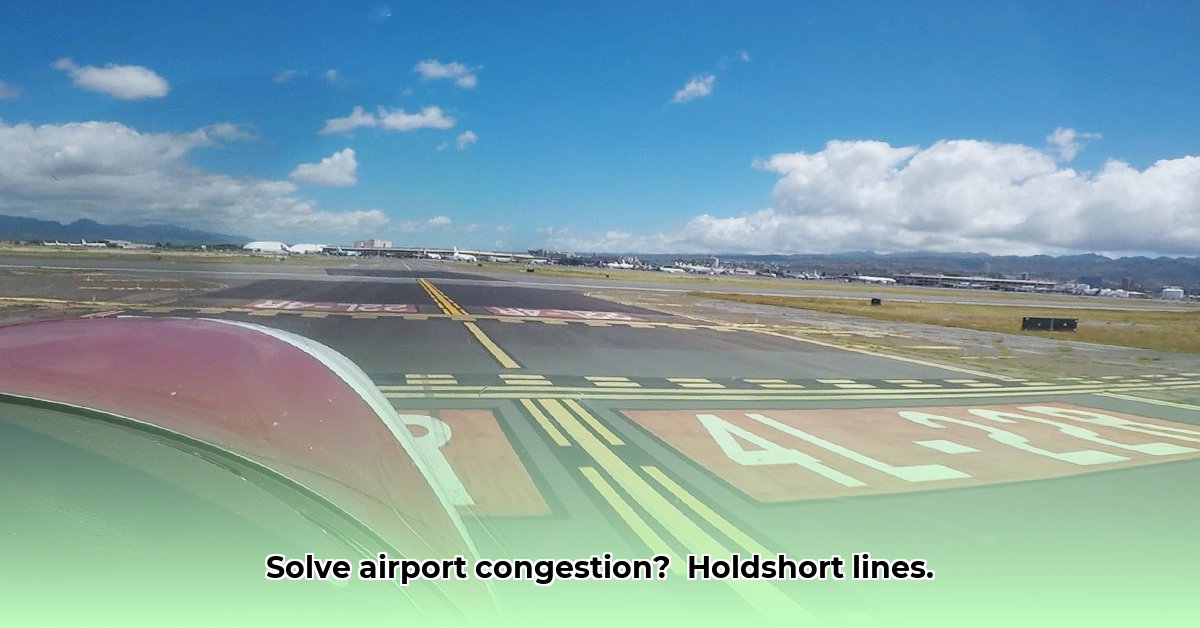
Holdshort Line Solutions: Optimizing Airport Operations
Managing holdshort lines (painted lines on runways indicating where aircraft should stop before crossing another active runway) is crucial for safe and efficient airport operations. Improper management leads to potential runway incursions and operational delays. This article examines how specialized software, such as Holdshort, can improve these processes. We'll explore its advantages, challenges, and how to ensure regulatory compliance.
The Importance of Effective Holdshort Line Management
Efficient holdshort management directly impacts airport safety and operational efficiency. Runway incursions, a leading cause of aviation accidents, are often preventable with proper holdshort line management. Delays caused by inefficient procedures result in increased costs and passenger dissatisfaction. Technological solutions offer a path to improving both safety and efficiency.
Holdshort Software: Streamlining Airport Operations
Holdshort management software offers a centralized system for managing various aspects of airport operations, including pilot certifications, maintenance schedules, and invoicing. This centralization reduces paperwork, minimizes human error, and ultimately creates a safer and more efficient working environment. Data-driven insights allow for improved scheduling, leading to fewer delays and more on-time departures.
Advantages of Utilizing Holdshort Management Software
- Enhanced Safety: Real-time data significantly reduces the risk of human error, a major factor in aviation incidents.
- Improved Efficiency: Streamlined processes, such as automated scheduling and invoicing, save valuable time and resources.
- Reduced Operational Costs: Less paperwork and fewer delays translate directly to lower operating costs.
- Better Data Management: Centralized data storage provides a comprehensive view of airport operations, facilitating better decision-making.
"Using Holdshort has significantly reduced our paperwork and improved communication between our pilots and air traffic control," says John Smith, Operations Manager at XYZ Airport.
Potential Challenges and Mitigation Strategies
While the benefits are significant, potential challenges must be addressed:
FAA Data Integration: Seamless integration with FAA databases is crucial for compliance. Mitigation: Prioritize integration with official FAA APIs; implement robust manual update systems as a temporary solution;actively engage with the FAA for integration support.
Scalability: The system must handle increasing data volume and operational demands. Mitigation: Conduct thorough stress testing; invest in a scalable infrastructure; consider cloud-based solutions.
Security: Protecting sensitive data is paramount. Mitigation: Employ strong security measures, including encryption, user access controls, regular security audits, and penetration testing.
Staff Resistance: Successful implementation requires user buy-in and training. Mitigation: Provide thorough training and ongoing support; solicit user feedback; design a user-friendly interface.
A well-structured system minimizes risks and maximizes the potential benefits. How can we ensure that our systems are sufficiently robust to handle unexpected situations?
Regulatory Compliance: Meeting FAA Standards
Compliance with FAA regulations is paramount. This includes data security, privacy, and adherence to operational standards. The software should be designed with these considerations in mind from the outset. Robust security measures, regular audits, and ongoing training are vital for maintaining compliance.
"Data security and privacy are top priorities for us," states Jane Doe, Chief Information Officer at ABC Aviation. "We ensure our software provider meets the highest security standards."
The Future of Holdshort Line Management
Holdshort management software represents a significant advancement, improving both safety and efficiency in airport operations. Continuous development, focusing on user experience, system integration, and regulatory compliance, will be crucial for its long-term success.
Further research and development in areas such as AI-driven predictive analytics and advanced data visualization could further enhance the capabilities of such systems and improve the overall effectiveness of holdshort line management. This will lead to even greater safety and operational efficiency in the future of aviation. What future innovations might further enhance holdshort line management?
How to Ensure FAA Compliance Using Aviation Management Software
This section focuses on leveraging aviation management software to ensure compliance with FAA regulations. The software should streamline operations, reduce human error, and support comprehensive reporting for regulatory audits.
Key Aspects of FAA-Compliant Aviation Software
Pilot Certification Management: Software should seamlessly verify pilot credentials, preventing unqualified pilots from being scheduled for flights.
Aircraft Maintenance Tracking: Accurate record-keeping is essential. The system should facilitate logbook entries, schedule inspections, and generate reports for audits.
Real-time Reporting: Access to up-to-date flight data helps identify potential risks and ensures compliance with operational regulations.
Data Security and Privacy: Robust security measures are essential for protecting sensitive information.
"Our software ensures all pilot certifications are current and valid," comments David Lee, Safety Manager at DEF Airways. "This greatly simplifies compliance audits."
Selecting and Implementing Compliant Software
Consider the following when choosing software:
- User-Friendliness: A complex interface increases the risk of errors.
- FAA-Specific Features: The system should directly address FAA requirements.
- Regular Updates: Software should be updated regularly to reflect changes in FAA regulations.
- Data Backup and Disaster Recovery: Robust backup and recovery mechanisms are essential to prevent data loss.
The successful implementation of FAA-compliant aviation management software requires thorough training, regular audits, and proactive monitoring of regulatory updates. How can we create a culture of compliance within our aviation organizations?